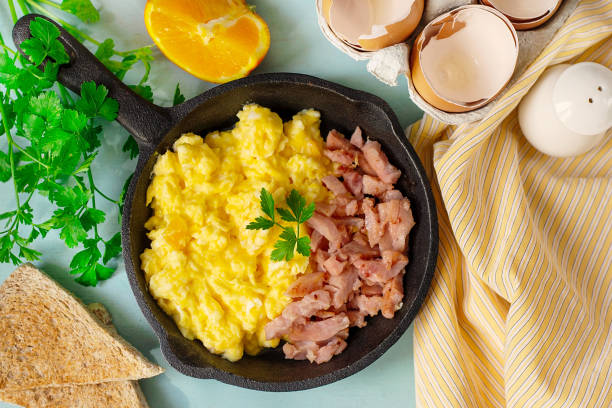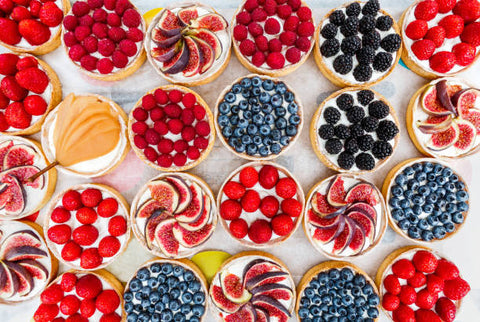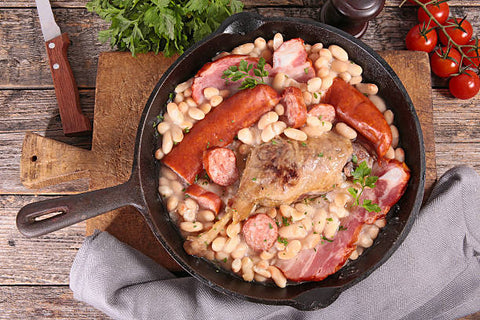Today, eggs are an everyday breakfast staple and a universally loved food, but not all scrambled eggs are equal. Some people prefer their eggs soft and creamy, while others like them firm and browned.
The French have a particular method for scrambling their eggs. That has garnered a reputation as the best in the world. They're known as "oeufs Brouillet." The term refers to the egg mixture's soft, almost soupy consistency. At restaurants, you'll commonly find them served with croutons or toast on the side for dipping.
French Scrambled eggs Julia child
If there's one dish that seems to be synonymous with French cooking, it's scrambled eggs. And if there's one recipe that is most often considered the best-scrambled eggs ever, it's Julia Child's recipe.
The secret for French scrambled eggs? It's not a secret at all — just a simple trick that makes a world of difference:
- Whip your eggs into froth before you cook them. Yes, it takes a little more time, but the results are worth it.
French Scrambled Eggs (Oeufs Brouilles À La Julia)
Ingredients
- 4 large eggs
- 1 tablespoon water
- 1/4 teaspoon salt
- 2 tablespoons unsalted butter
Directions for cooking
Beat together the eggs, water, and salt until thickened and mixed in a medium bowl. This will take about 3 minutes. The mixture should have soft peaks when you lift your whisk.
Place the butter in an 8-inch grill pan over low heat. When melted and hot (but not bubbling), add the egg mixture and stir slowly with a wooden spoon or rubber spatula until the eggs form curds. Do not scramble; instead, stir gently to encourage large curds to form.
When the eggs look creamy and uncooked but are starting to come together, As soon as they begin to set, lower the heat and continue stirring slowly but constantly until they are thickened but still moist—don't let them get dry or rubbery. Remove them from the heat and beat in the salt, pepper, and cream. The eggs should be moist but not runny.
Julia Child's Kitchen Wisdom:
"This is my invariable advice to people: Learn how to cook— try new recipes, learn from your mistakes, be fearless, and above all, have fun!"
The following is an excerpt from the introduction of Julia Child's Kitchen Wisdom.
- Cooking has never been a chore to me; rather a pleasant diversion from whatever else was happening in my life.
- I always enjoy washing up, too—it's a form of meditation for me. If you don't like doing the dishes afterward, you will not enjoy cooking.
- And it would be best if you certainly didn't think about the calories you're consuming or about how tough the meat is when it comes to the table.
- Just relax and enjoy yourself and the meal!
French Scrambled eggs Gordon Ramsey
When you think of scrambled eggs, you probably envision a yellow block of egg curds. That's how I had been making them for years until I discovered the French method, which results in creamy, almost fluffy eggs.
This trick comes from Gordon Ramsay's scrambled-egg tutorial, which is worth watching in full if only to hear the chef's soothing voice.
French scrambled eggs, or oeufs brouilles a la Parisienne, are like our own, but the French always add a little cream, making them tenderer. Gordon Ramsay's twist on this classic is a dash of booze – he uses vodka to make his eggs light and fluffy, but you can use brandy or even whisky if you prefer.
This recipe is taken from Gordon Ramsay's Ultimate Cookery Course:
Ingredients
- 2 large eggs
- 20g butter
- 1 tbsp. double cream
- 1 tbsp. vodka (or brandy/whisky)
- Salt and pepper
Directions for cooking
- Beat the eggs, cream, and vodka together in a bowl with some seasoning until fluffy.
- Melt the butter in a pan over medium heat and cook the eggs for 1 min.
- Stirring all the time with a wooden spoon until just set. Now your French scrambled egg is ready to eat.
Cook's illustrated French Scrambled eggs:
When making scrambled eggs, the most important thing to remember is to cook the egg on low heat. As soon as the whites set, immediately remove them from the heat. The residual heat will continue to cook the eggs through to perfection, but if you leave them on the heat too long, they will become rubbery. A perfectly cooked scrambled egg should be almost creamy and soft in texture.
It may seem obvious, but one thing I've found that helps is using a pan that is large enough to accommodate both your eggs and your spatula. If you try to mix or fold your eggs in a small pan, there won't be room for this to happen, and inevitably you will end up breaking and scrambling your eggs early.
- Another critical tip for perfect scrambled eggs is to use cream rather than butter.
- The cream adds moisture and richness but does not burn like butter does at high heat.
You don't need to be the world's most fabulous chef to make perfect scrambled eggs. Although the process is simple, it requires a certain amount of care and finesse. Here are some tips for getting your eggs just right.

Use Good Eggs
It may seem obvious, but it's worth mentioning: The quality of the eggs you use makes a big difference in the flavor and texture of the dish. We prefer using farm-fresh eggs; they contain a higher proportion of yolks, which means fluffier curds.
Add Salt Later
Adding salt directly to the beaten eggs can intensify their coagulating ability, resulting in rubbery curds. We prefer to add salt after the eggs have been cooked and removed from the heat for a soft texture with a clean egg flavor.
Clear Pan with Water
While a nonstick pan is ideal for scrambling eggs, we find that a well-seasoned cast-iron or stainless steel pan works just as well if you clear it with water before adding the eggs. This step helps prevent sticking and keeps the curds moist by reducing evaporation while cooking.
Stir Occasionally
Scrambled eggs should be stirred throughout cooking.
French Scrambled eggs double boiler
French-style scrambled eggs, or oeufs brouilles, are a world away from the quick and easy version. Cooked slow and low, they're as rich and creamy as they are luxurious.
There are two keys to this;
Firstly, the eggs must be stirred constantly over a gentle heat you can't stop stirring once you've started – but it's essential to use a double boiler (or bain-marie). This way, the eggs cook in the steam of the simmering water rather than direct heat.
The second key is to add soft butter while cooking – we usually add a knob every 15 seconds. It gives the eggs an incredibly silky texture without making them greasy.
To finish off, we like to add a little cold butter at the end for extra creaminess and serve with steamed baby spinach, sautéed mushrooms, and crusty bread.
How to Scramble Eggs in a Double Boiler:
- Fill the bottom half of a double boiler with water. Bring the water to a boil over medium-high heat.
- Set the double boiler's top half on top of the bottom half. Make sure that it fits securely and does not wiggle around.
- Crack 2 to 3 eggs into a small bowl, depending on how many people you feed. Add 1 teaspoon (tsp.) of milk or cream for every egg you use to the bowl with the eggs, and whip them together with a fork or whisk until well blended.
- Place the bowl into the top half of your double boiler. Constantly stir with a spoon until the eggs are cooked to your liking. If you like your eggs soft, take them off when they are still a little runny; if you like them firm, wait until they are more solid before removing them from heat. If you want your eggs very firm, add 1/2 tsp. (2 ml) of butter per egg to make them extra creamy.
Scrambled Eggs with Herbs:
If you've got a bunch of fresh herbs to use up, stir them into your eggs while they're cooking. You don't need much — 1 tablespoon of chopped herbs per egg should do it. Just toss the herbs in with the eggs and scramble until set.
Scrambled Eggs with Cheese:
While you can undoubtedly stir shredded cheese directly into scrambled eggs, I like to melt cheese on top, as you would for an omelet. It's quick and easy to do. Once the eggs are done, lay slices of your favorite cheese over half the pan and let it melt a little before folding.
Cheesy Scrambled Eggs with Spinach:
Cheesy Scrambled Eggs with Spinach is my go-to low-effort breakfast when I try to eat light but still want something hearty and filling. Add a big handful of baby spinach to the pan when the eggs are almost set, then top with slices of cheese while they finish cooking. The spinach will wilt under the heat, and the cheese will melt into everything.
Scrambled eggs are the most basic of essential beginner recipes. But there are so many different ways to make them, and it's so easy to mess them up that I thought they deserved a complete guide of their own.
Read on for all of our tips and techniques:
- Scrambled Eggs in the Pan
Everyone knows this classic technique: You add beaten eggs to a hot pan with butter, then scramble them as they cook. It is easier than omelets since you don't need to flip the eggs over during cooking. But if you over-stir them, you'll end up with tiny curds instead of creamy ones. Make sure your pan isn't too hot or too cool.
- Scrambled Eggs in the Microwave
The microwave can also be used for scrambling eggs. Many people prefer this method because it's easier to control how much the eggs cook as you go along. But it does require a bit more stirring than the stovetop method.
- Scrambled Eggs in the Oven
When you're cooking scrambled eggs for a crowd, baking them in an oven can be helpful because you don't have to stand over the stove and stir constantly. The major drawback is that eggs in the oven egg become hard.
Comparing French scrambled eggs with American scrambled eggs
The French scramble and the American scramble are two different things. The French scramble is simmered over low heat and does not form distinct curds. It is entirely smooth and silky. The American scramble is cooked quickly, over high heat, and forms distinct curds. You can't use one method to cook the other.
The French scramble is made in a single pan (usually a nonstick pan) with butter and a little water. The eggs are whisked just before they're added to the pan, making them lighter and fluffier, with more air bubbles. As they cook, you stir them gently with a wooden spoon or rubber spatula until they reach the desired consistency.
The American scramble is often made in batches — one person cooks while someone else whisks the eggs — and it's usually made in a skillet or sauté pan with no water added at all. The eggs are whisked just before they're added to the pan, making them lighter and fluffier, with more air bubbles. As they cook, you stir them vigorously with a wooden spoon or rubber spatula until they reach the desired consistency.
Tip for making French Scrambled eggs:
When you're scrambling eggs for a crowd, try this hack:
- Mix the eggs with some chopped fresh herbs and then pour the mixture into a baking dish.
- Bake in the oven until just set. It's so much easier than standing at the stove stirring — and it will earn you mad entertaining skills.
In the end I will say that, once you understand how each scrambled egg type works, it's easy to make French Scrambled egg at home.




